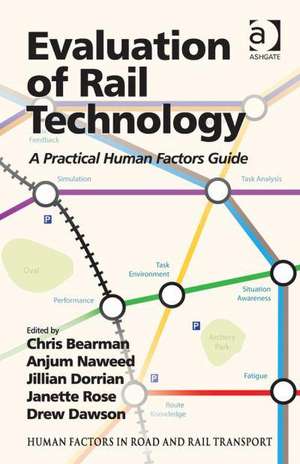Evaluation of Rail Technology: A Practical Human Factors Guide: Human Factors in Road and Rail Transport
Autor Anjum Naweed Editat de Chris Bearman Autor Jillian Dorrian, Janette Roseen Limba Engleză Hardback – 11 oct 2013
| Toate formatele și edițiile | Preț | Express |
|---|---|---|
| Paperback (1) | 390.50 lei 3-5 săpt. | +20.85 lei 10-14 zile |
| CRC Press – 16 apr 2017 | 390.50 lei 3-5 săpt. | +20.85 lei 10-14 zile |
| Hardback (1) | 1118.65 lei 6-8 săpt. | |
| CRC Press – 11 oct 2013 | 1118.65 lei 6-8 săpt. |
Din seria Human Factors in Road and Rail Transport
- 8%
 Preț: 390.50 lei
Preț: 390.50 lei - 8%
 Preț: 390.50 lei
Preț: 390.50 lei - 25%
 Preț: 861.11 lei
Preț: 861.11 lei - 15%
 Preț: 427.16 lei
Preț: 427.16 lei - 18%
 Preț: 1117.07 lei
Preț: 1117.07 lei - 15%
 Preț: 455.31 lei
Preț: 455.31 lei - 15%
 Preț: 427.16 lei
Preț: 427.16 lei - 15%
 Preț: 427.16 lei
Preț: 427.16 lei - 15%
 Preț: 427.16 lei
Preț: 427.16 lei - 21%
 Preț: 336.66 lei
Preț: 336.66 lei - 15%
 Preț: 431.25 lei
Preț: 431.25 lei - 22%
 Preț: 355.49 lei
Preț: 355.49 lei - 22%
 Preț: 353.39 lei
Preț: 353.39 lei - 18%
 Preț: 1008.97 lei
Preț: 1008.97 lei - 15%
 Preț: 426.20 lei
Preț: 426.20 lei
Preț: 1118.65 lei
Preț vechi: 1364.20 lei
-18% Nou
Puncte Express: 1678
Preț estimativ în valută:
214.07€ • 222.14$ • 178.93£
214.07€ • 222.14$ • 178.93£
Carte tipărită la comandă
Livrare economică 15-29 martie
Preluare comenzi: 021 569.72.76
Specificații
ISBN-13: 9781409442431
ISBN-10: 1409442438
Pagini: 334
Dimensiuni: 156 x 234 x 19 mm
Greutate: 0.73 kg
Ediția:New.
Editura: CRC Press
Colecția CRC Press
Seria Human Factors in Road and Rail Transport
ISBN-10: 1409442438
Pagini: 334
Dimensiuni: 156 x 234 x 19 mm
Greutate: 0.73 kg
Ediția:New.
Editura: CRC Press
Colecția CRC Press
Seria Human Factors in Road and Rail Transport
Notă biografică
Dr Chris Bearman is a Postdoctoral Research Fellow at the University of South Australia and a Senior Research Associate at NASA Ames Research Center, USA. His work involves conducting industry-focused research in laboratory and field settings with the aim of creating results that have both a strong theoretical underpinning and a robust application to industry. Currently he is working on the FAA/NASA Next Generation Project which seeks to redesign the American Airspace System, as well as a number of Rail projects in Australia that examine issues concerned with the human factors implementation of new technologies. Dr Anjum Naweed is a Senior Postdoctoral Research Fellow at the Appleton Institute of Central Queensland University, Australia. He currently leads six research projects with the Australian Cooperative Research Centre (CRC) for Rail Innovation. His work is investigating the area of safety and security on topics involving train driver psychology, complex decision-making, knowledge representation, level crossing design, work health and safety, and participative processes at work. He was recently awarded the Body of Knowledge prize at the Asia-Pacific Simulation Training and Technology conference for best contribution to standards development, capture of best practice or contribution to the simulation community. Dr Jillian Dorrian is a Senior Lecturer in Psychology at the University of South Australia. She specializes in the area of human sleep, biological rhythms and performance. She has worked extensively with the Rail industry investigating sleep loss, workload, operational performance, safety and health. Her work has focused on understanding the issues related to safety and performance in train driving, particularly fatigue and self-awareness. She currently collaborates with the Australian CRC for Rail Innovation on a number of simulator research projects looking at knowledge representation, workplace culture and generating evidence-based guidelines for s
Cuprins
Foreword; Introduction: the promise and perils of new technology, Drew Dawson, Chris Bearman, Anjum Naweed and Gareth Hughes; Key technology-related human factors issues, Chris Bearman; Resistance to technology, Janette Rose and Chris Bearman; Effective user feedback: the practical value of mock-ups, Gareth Hughes, Airdrie Long, Anne Maddock and Chris Bearman; Qualitative research rules: using qualitative and ethnographic methods to access the human dimensions of technology, Kirrilly Thompson; Future enquiry: a participatory ergonomics approach to evaluating new technology, Verna Blewitt and Andrea Shaw; Using task analysis to inform the development and evaluation of new technologies, Janette Rose, Chris Bearman and Anjum Naweed; Evaluating your train simulator part I: the physical environment, Anjum Naweed, Ganesh Balakrishnan and Jillian Dorrian; Evaluating your train simulator part II: the task environment, Jillian Dorrian and Anjum Naweed; Applying the theories and measures of situation awareness to the rail industry, Janette Rose, Chris Bearman and Anne Maddock; Index.
Recenzii
’This is not a beginner’s guide to Human Factors but then the rail industry is no longer a beginner. It is a technical book, rich in detail and insight, but also one that has itself been designed for Human Use. It is easy to read, being in equal part a railway book as much as it is a human factors one.’ Rail Professional, December 2013
Descriere
Currently, the rail industry lacks a standardized approach to the human factors evaluation of new technologies in operational settings. While a number of human factors evaluation methods exist (such as task analysis, situation awareness measures, quasi-experiments), these are rarely tailored to the industry’s needs. This book fills that gap by developing a toolkit of methods that can be used by people in the rail industry to evaluate the human factors implications of new technologies.





